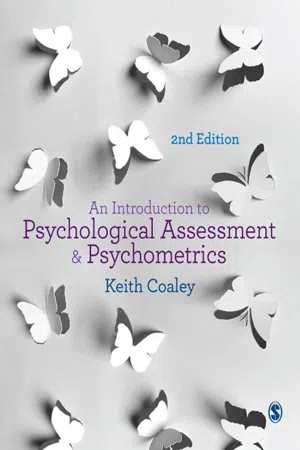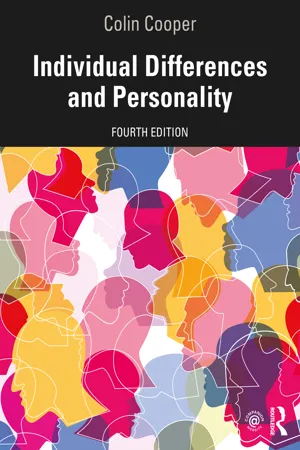Psychology
Measuring Individual Differences
Measuring individual differences involves assessing and quantifying the variations in psychological characteristics among people. This can include traits such as intelligence, personality, and abilities. Psychologists use various methods, such as tests and questionnaires, to measure these differences, which can provide valuable insights into understanding human behavior and predicting outcomes in different contexts.
Written by Perlego with AI-assistance
Related key terms
1 of 5
9 Key excerpts on "Measuring Individual Differences"
- Keith Coaley(Author)
- 2014(Publication Date)
- SAGE Publications Ltd(Publisher)
An Introduction to Psychological Assessment and Psychometrics. We can only evaluate the similarities and the differences between people through the use of modern forms of assessment and valid psychometric tests. In the twenty-first century the use of armchair observation has long gone. By reading this book you will learn about the theories and how to measure the differences.The study of individual differences has grown over a long period, sometimes being called ‘differential psychology’. The importance of this was stressed by Anne Anastasi (1937) when she wrote ‘It is apparent that if we can explain satisfactorily why individuals react differently from each other, we shall understand why each individual reacts as he does’. To determine the unique characteristics of someone we need to both identify and quantify the differences with others. Social comparison theory suggests, in fact, that we learn how to define the self by comparing ourselves with others (Festinger, 1954).Why Measure Individual Differences?
The benefits are enormous. Tests identify differences in a number of ways, for example in measuring different levels of clinical, forensic, educational or neuropsychological problems, as well as in helping commercial organizations to select or develop their people. In their classic (1997) text Anastasi and Urbina point to their significant role in basic research: for example, studies on the nature and extent of individual differences; the organization of psychological traits; the measurement of group differences; and the identification of biological and cultural factors associated with behavioural differences. Reliable and valid tests provide the principal scientific approach to the measurement of differences between people.Let’s look at this in a practical way. If you want to assess somebody, for what purpose would you wish to do so? You might want to discover, for example, whether that person can stay calm in a crisis or is confident in social situations, or whether he or she is anxious or depressed. Perhaps you want to say: ‘Yes, John is calm in a crisis’ or ‘June is socially confident’. Similarly, you might say: ‘John is anxious’ or ‘June is depressed’. Would those results then be good enough for you?- eBook - ePub
- Colin Cooper(Author)
- 2020(Publication Date)
- Routledge(Publisher)
Chapter 3Measuring Individual Differences
Introduction
The previous chapter mentioned the use of a questionnaire to measure self-esteem, but it did not go into any detail about how questionnaires and tests are constructed, used and evaluated. If we are unable to actually measure people’s levels of self-esteem, anxiety, intelligence or other characteristics accurately, then the study of individual differences can never be scientific or quantitative; it will be difficult to test theories, or to assess these characteristics for the purpose of diagnosis, individual guidance or personnel selection. So before studying other theories it seems sensible to pause and to discuss how we can go about Measuring Individual Differences; more detail about designing and using tests and questionnaires is given in Chapters 20 and 21 .This chapter thus provides an introduction to psychometrics, the branch of psychology that deals with the measurement of individual differences. It introduces the concepts of trait and state. Various types of psychological test are outlined and the interpretation of individual scores through the use of norms is discussed. Finally, some guidance is given as to how to select a test and use it ethically. - eBook - ePub
- Bere Mahoney(Author)
- 2011(Publication Date)
- Learning Matters(Publisher)
Cervone, 2005 ). This relatively narrow focus has, to some extent, been aggravated by the effects of specialisation – or separatism – in the field, a trend that some regard as problematic because:a much richer picture of humanity and psychological diversity is brought into focus when constellations of individual-differences variables are assembled for research and practice.(Lubinski, 2000 , p407)In Chapter 2 you will therefore consider how the relationship between individual differences psychology and other fields in psychology is increasingly being questioned (Sternberg et al., 2001 ). Nevertheless, the psychometric approach remains dominant in the field, meaning that the integrity of individual differences psychology continues to depend on the soundness of this approach.The term psychometrics literally means the measurement of psychological phenomena or mental processes (Bartram and Lindley, 2005 ), and in individual differences psychology this means the measurement of psychological phenomena we refer to as individual differences. Measurements or measures of individual differences we collect in the field are therefore central to the psychometric approach. Measures of individual differences, or individual differences data, are used in real contexts to make important decisions about individuals or groups of individuals (Lubinski, 2000 ; Revelle et al., 2010 ). Consequently, the measurements we use in individual differences psychology, along with the methods we use to collect the data that form these measures, have social significance. This is because they are used in real contexts to make important decisions about individuals or social groups (Lubinski, 2000 ; Revelle et al., 2010 ). The field’s contribution to such high-stakes decision making about individuals and groups in the domains of education, work, mental health and the criminal justice system remains unabated and substantial (Revelle et al., 2010 ). Thus the theoretical and empirical findings of the field have both academic and real world significance. The reality is that the access of individuals and social groups to certain resources and opportunities in the domains of education, training, work and within the criminal justice system involve the collection and interpretation of individual differences measures and data. This means that when working in the field – whether as academics, practitioners or students – our conduct is of ethical and professional importance. In this chapter we will therefore also consider some of the ethical and professional responsibilities we have in the field. Our overarching responsibility is to ensure that we competently and respectfully uphold the highest possible standards of quality in the methods of data collection we use, the data we collect and our interpretation of such data, or its analysis and evaluation. The importance of these issues means we will return repeatedly to these issues throughout this book. Ethics and professional conduct are also issues that are an important part of your reflective critical thinking - eBook - PDF
Work in the 21st Century
An Introduction to Industrial and Organizational Psychology
- Jeffrey M. Conte, Frank J. Landy(Authors)
- 2018(Publication Date)
- Wiley(Publisher)
intelligence test Instru- ment designed to measure the ability to reason, learn, and solve problems. 90 Chapter 3 Individual Differences and Assessment Differential Psychology, Psychometrics, and I-O Psychology Nearly a century later, measuring the differences among individuals to predict later behavior (“psychometrics”) remains one of the most common frameworks applied by I-O psychologists. It is different from the framework used by an experimental psychologist. The experimental psychologist usually designs an experiment that will show how all people are alike in their response to a stimulus and looks outside the individual to the stimulus as a way to explain behavior. In contrast, the differential psychologist is person-centered, looking for qualities or characteristics within the person that will help us understand that person’s behavior. In the past, I-O psychol- ogy, particularly the applied aspect of it, depended on these differences to predict things such as job success, job satisfaction, and counterproductive work behavior. I-O psychology still makes great use of the individual differences approach, but it also considers factors such as organizational practices, team characteristics, physical work and work environment design, and even broad cultural influences. The marriage of psychometrics and differential psychology was a good one. The differential psychologist identified what should be measured, and the psychometri- cian set about measuring it. As we saw from the work of Cattell and his contem- poraries, the attribute most often measured—and considered most important—was some form of intelligence, or cognitive ability. People use cognitive abilities to acquire knowledge, solve problems, and apply reason to situations. Consequently, many studies were conducted to show that an individual’s general intellectual capac- ity was closely associated with that individual’s occupational and vocational success. - Andrew J. Vinchur(Author)
- 2018(Publication Date)
- Cambridge University Press(Publisher)
6 For the interested reader, Stigler (1999) provides a chapter-length discussion of why psychology predated economics and sociology in the use of statistics. Individual Differences 55 the differences between individuals by the methods of experimental science was after all the most important advance toward the practical application of psychology. The study of individual differences itself is not applied psy- chology, but is the presupposition without which applied psychology would have remained a phantom” (p. 10). A few years later, in his 1919 presidential address to the members of the APA, industrial psychologist Walter Dill Scott stated: “Possibly the greatest single achievement of the members of the American Psychological Association is the establishment of the psychology of individual differences” (Scott, 1920, p. 85). This was most likely news to the academic, experimentalist members of the APA, who were invested in discovering general laws of behavior and mental functioning and viewed individual differences as a problem to be con- trolled, not celebrated. But for industrial psychologists such as Scott, individual differences formed a foundation for much of their science and practice. The existence and measurement of these differences allowed the psychologist to determine which applicant has the best chance of success in a particular job, which vocation is the best fit for an individual, or which type of training is most suitable for an employee. Three individuals who played key roles in the early attempts to understand and accurately measure those differences were Francis Galton, James McKeen Cattell, and William Stern. While Galton and Cattell’s anthropometric testing procedures did not prove viable in the long run, they did demonstrate the possibilities for measurement in psychology. They set the stage for more enduring approaches to psychological measurement, such as the cognitive tests of Alfred Binet.- eBook - ePub
Human Performance
Cognition, Stress and Individual Differences
- D. Roy Davies, Gerald Matthews, Rob B. Stammers, Steve J. Westerman(Authors)
- 2013(Publication Date)
- Psychology Press(Publisher)
Individual differences in ability and performance14.1 Investigating Individual DifferencesOn any task, some people perform better than others, even when the amount of practice is controlled. Individuals differ in their ability or basic aptitude for performing the task concerned. This chapter addresses the nature and practical significance of individual differences in ability. Research on ability and performance brings together several rather different research traditions. These include psychometric research focused on detailed statistical modelling of ability, applied research geared to predicting real-world performance, and cognitive psychological research concerned with individual differences in information processing. Hence, the chapter focuses on the interrelation of three types of construct:- Psychometric ability factors such as general intelligence or g , such as those measured by conventional IQ tests. Ability tests aim to abstract some general quality which may relate to individual differences in performance on a variety of tasks.
- Measures of laboratory and real-world task performance (molar measures). Ability research is concerned with the prediction and understanding of individual differences in performance.
- Elementary information-processing constructs, with a basis in theory (molecular measures). Researchers often wish to explain individual differences in performance on more complex tasks in terms of specific processes.
14.1.1 Theory and practice in ability research
The first step in ability research is to describe and characterise the major dimensions of ability. In the intelligence field, for example, there has been much debate between researchers who favour a single overarching ability (g - eBook - PDF
- Angel Blanch(Author)
- 2020(Publication Date)
- Cambridge University Press(Publisher)
Chess has also been suggested as an ideal model environment for the study of individual differences in the acquisition and development of expertise (Chabris, 2017; Charness, 1992; Gobet, 2016; van der Maas & Wagenmakers, 2005). In this view, studying individual differences in chess can contribute to unearthing how, when, and why humans differ when involved in a complex intellectual endeavour. Differential psychology is a useful conceptual and methodological approach to address such a different class of questions from those addressed so far from a cognitive psychology approach (Revelle, Wilt, & Condon, 2011). A considerable body of research within several fields and subfields of neurosciences and behavioural sciences advocates for the crucial significance of individual differences in explaining human behaviour. Several studies point out that there are consistent associations between brain anatomy 38 and functioning and inter-individual differences in motor behaviour and learning, perception, higher-level cognition, and intelligence and personality (Kanai & Rees, 2011). Furthermore, individual differences in core psycho- logical constructs such as intelligence, personality, and vocational interests account for meaningful variations in a vast array of behaviours that are readily observable and of cardinal importance for contemporary society (Lubinski, 2000). This chapter is divided into three main sections. The first, on the character- ization and appraisal of individual differences, describes the object of study and kinds of questions addressed by differential psychology, the definition and classification of psychological traits, and the main research designs in the field. - No longer available |Learn more
- Wayne F. Cascio, Herman Aguinis(Authors)
- 2018(Publication Date)
- SAGE Publications, Inc(Publisher)
6 Measuring and Interpreting Individual Differences Wayne F. Cascio, Herman AguinisLearning Goals
By the end of this chapter, you will be able to do the following:- 6.1 Distinguish among nominal, ordinal, interval, and ratio scales of measurement and learn which types of data analysis can be conducted with each
- 6.2 Implement procedures and criteria for choosing to use an existing test or develop a new one
- 6.3 Understand the use of item response theory to conduct comprehensive item analyses
- 6.4 Estimate reliability using procedures such as test–retest, parallel forms, internal consistency, and interrater reliability to assess different sources of error (e.g., time, items, raters)
- 6.5 Interpret and use reliability information
- 6.6 Understand the use of generalizability theory to learn about the relative contribution of different sources of error
- 6.7 Create measures that minimize the detrimental effects of scale coarseness and interpret results of measurement procedures, taking into account norms and other contextual issues
- 6.8 Anticipate future trends in applied psychological measurement given technological and other contextual changes
Have you ever visited a clothing factory? One of the most striking features is the vast array of clothing racks, each containing garments of different sizes. Did you ever stop to think of the physical differences among wearers of this clothing? We can visualize some of the obvious ways in which the people who will ultimately wear the clothing differ. We can see large people, skinny people, tall people, short people, old people, young people, and people with long hair, short hair, and every imaginable variant in between.Applied psychology’s first law is glaringly obvious: People are different. They differ not only in physical respects but also in a host of other ways (Sackett, Lievens, Van Iddekinge, & Kuncel, 2017). Consider wearers of size 42 men’s sport coats, for example. Some will be outgoing and gregarious, and others will be shy and retiring; some will be creative, and others will be unimaginative; some will be well adjusted, and some will be maladjusted; some will be honest, and some will be crooks. Physical and psychological variability is all around us. As scientists and practitioners, our goal is to describe this variability and, through laws and theories, to understand it, to explain it, and to predict it. Measurement is one of the tools that enables us to come a little bit closer to these objectives. Once we understand the why of measurement, the how - eBook - PDF
- Robert Hogan, John Johnson, Stephen Briggs(Authors)
- 1997(Publication Date)
- Academic Press(Publisher)
Idiothetic inquiry is not about placing bets, with the objective of maximizing payoffs in the long run. It is not about regarding persons as things or as mere matter (see the above cited works by Stern). It is about the serious business of advancing theoretical conceptions of individual behavior-psychological functioning, toward the end of improving our understanding of ourselves and one another. I do not know for certain that the framework as I have sketched it up to now will get us where we want to go. I do know that the long-dominant individual differences paradigm will not. It is time to move on. The epistemological basis for doing so is at hand, even if an exquisitely detailed map of all of the territory is not. REFERENCES AUport, G. W. (1937). Personality: A psychological interpretation. New York: Holt, Rine-hart & Winston. AUport, G. W. (1955). Becoming: Basic considerations for a psychology of personality. New Haven, CT: Yale University Press. AUport, G. W. (1962). The general and the unique in psychological science. Journal of Personality, 30, 405-422. AUport, G. W. (1966). Traits revisited. American Psychologist, 21, 1-10. Angleitner, A. (1991). Personality psychology: Trends and developments. European Journal of Personality, 5, 185-197. Asendorpf, J. B. (1988). Individual response profiles in the behavioral assessment of personal-ity. European Journal of Personality, 2, 155-167. Asendorpf, J. B. (1995). Pers6nlichkeitspsychologie: Das empirische Studium der individuel-len Besonderheit aus spezieller und differentieller Perspektive [Personality psychology: The empirical study of individuality from special and different perspective]. Psychologi-sche Rundschau, 46, 235-247. Bakan, D. (1966). The test of significance in psychological research. Psychological Bulletin, 66, 423-437. CHAPTERS INDIVIDUALS AND DIFFERENCES 139 Beck, S. J. (1953). The science of personality: Nomothetic or idiographic? Psychological Review, 60, 353-359.
Index pages curate the most relevant extracts from our library of academic textbooks. They’ve been created using an in-house natural language model (NLM), each adding context and meaning to key research topics.








